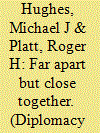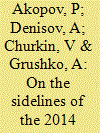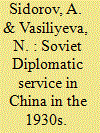| Srl | Item |
| 1 |
ID:
080951


|
|
|
|
|
| Publication |
2008.
|
| Summary/Abstract |
The Lisbon Treaty adapts the EU's institutional structures into a new architecture for foreign affairs. It creates a High Representative for Foreign Affairs and Security Policy with responsibility as Vice-President in the Commission for work on external affairs ("first pillar") and in the Council for common foreign and security policy ("second pillar"). To assist this person in his/her tasks it creates a European External Action Service and Union Delegations in non-EU countries, which may develop into a European Diplomatic Service. The article examines the service's tasks, timing, institutional place, staff, structure and budget, and the participation of EU member states
|
|
|
|
|
|
|
|
|
|
|
|
|
|
|
|
| 2 |
ID:
139828


|
|
|
|
|
| Summary/Abstract |
A good deal has been written about the organisation and structure of the British diplomatic establishment since 1945. This analysis uses detailed quantitative and qualitative data to develop an understanding of the background and career trajectories of the most senior figures in the Diplomatic Service in 1975. By tracing their careers, it is possible to identify more precisely than before the changing educational and social background of these individuals when compared with previous generations of diplomats. This analysis also examines certain core features of the culture of the diplomatic establishment during the post-war decades, analysing how it both shaped and was shaped by particular structures and practices. Despite the existence of a peripatetic career structure that dispersed members of the diplomatic establishment around the globe, there were still numerous opportunities for the kinds of personal contact necessary to maintain an integrated culture.
|
|
|
|
|
|
|
|
|
|
|
|
|
|
|
|
| 3 |
ID:
137323


|
|
|
|
|
| Summary/Abstract |
Pogos Akopov, president of the Association of Russian Diplomats, Distinguished Worker of the Diplomatic Service, Ambassador Extraordinary and Plenipotentiary: I was lucky enough to participate in all the conferences, starting from the first one. This very important event at the Foreign Ministry with the participation of all foreign representatives, all ambassadors plays a special role. The head of state, who oversees the Foreign Ministry, speaks here. It is extremely important for ambassadors, permanent representatives of our country abroad to hear his assessment of the situation in the world.
|
|
|
|
|
|
|
|
|
|
|
|
|
|
|
|
| 4 |
ID:
165646


|
|
|
|
|
| Summary/Abstract |
ANY STATE realizes its foreign policy through its diplomatic corps. As an official representative of his country, any diplomat defends the interests of his state and of its citizens and participates in talks and other events.
|
|
|
|
|
|
|
|
|
|
|
|
|
|
|
|
| 5 |
ID:
188510


|
|
|
|
|
| Summary/Abstract |
AS THE WORLD was moving toward World War II, Soviet leaders and the People's Commissariat for Foreign Affairs (NKID) were paying as much attention to China as to the situation in Europe. By the early 1930s, Moscow no longer had diplomatic relations with China (they had been severed by the Chiang Kai-shek government in 1927, when the Kuomintang dissolved the [first] united front with the Communist Party of China). In 1929, in the wake of armed conflict over the Chinese Eastern Railway (CER), the Soviet Union closed its consulates in Manchuria (they reopened in 1930 after the Khabarovsk Protocol was signed that ended the conflict). Soviet consulates continued functioning in Xinjiang, which at that time was not controlled by the central Chinese government. A Soviet Embassy and five consulates functioned in the Mongolian People's Republic, which Moscow treated as an independent state while formally recognizing Chinese sovereignty over it.
|
|
|
|
|
|
|
|
|
|
|
|
|
|
|
|